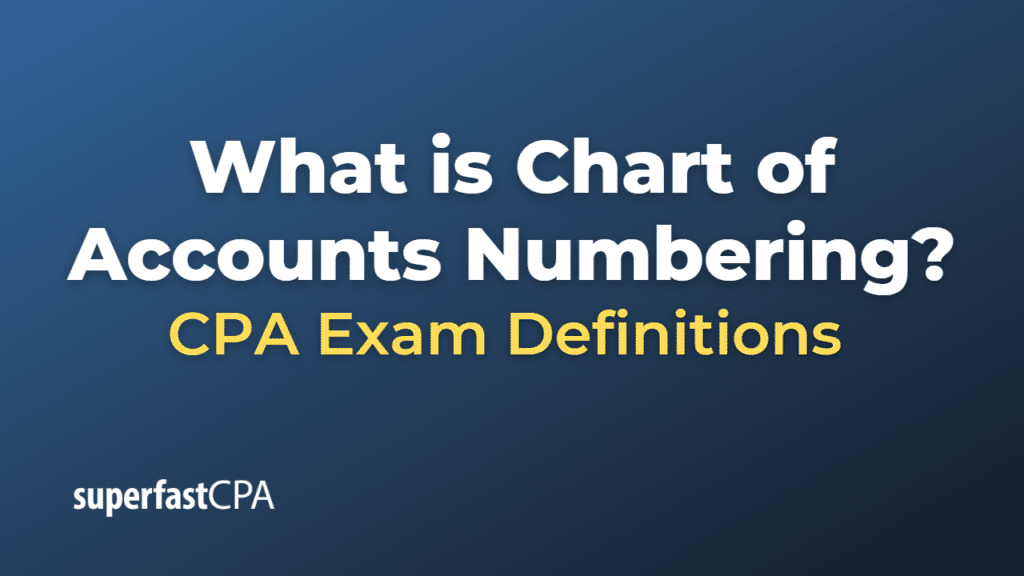Chart of Accounts Numbering
Chart of Accounts Numbering refers to the system of assigning unique numbers or codes to each account within a company’s Chart of Accounts. This numbering system helps to organize, classify, and manage the accounts in a structured manner, which, in turn, facilitates data entry, report generation, and financial analysis.
The numbering system for a Chart of Accounts typically follows a standardized format, with different ranges of numbers assigned to each of the main categories: assets, liabilities, equity, revenue, and expenses. The accounts within each category are further subdivided using additional digits to represent subcategories or specific accounts.
Here is a general overview of how Chart of Accounts numbering might be structured:
- Assets
1000 – 1999: Current Assets
1010: Cash
1020: Accounts Receivable
1030: Inventory
2000 – 2999: Fixed Assets
2010: Buildings
2020: Equipment
2030: Vehicles - Liabilities
3000 – 3999: Current Liabilities
3010: Accounts Payable
3020: Short-term Loans
3030: Sales Tax Payable
4000 – 4999: Long-term Liabilities
4010: Mortgage Payable
4020: Long-term Loans - Equity
5000 – 5999: Owner’s Equity
5010: Owner’s Capital
5020: Retained Earnings - Revenue
6000 – 6999: Revenue Accounts
6010: Sales Revenue
6020: Interest Income
6030: Other Income - Expenses
7000 – 7999: Expense Accounts
7010: Cost of Goods Sold
7020: Salaries and Wages
7030: Rent Expense
7040: Utilities Expense
7050: Depreciation Expense
7060: Advertising Expense
7070: Interest Expense
The exact numbering structure and ranges may vary depending on the size and complexity of the business, as well as the accounting software or system being used. The goal is to create a logical, organized, and easy-to-follow numbering system that accurately reflects the company’s financial transactions and reporting needs.
It is essential to keep the Chart of Accounts numbering up-to-date and consistent, as it directly impacts the accuracy and usefulness of the company’s financial statements. Regular reviews and adjustments may be necessary to ensure that the numbering system aligns with the financial activities and structure of the business.
Example of Chart of Accounts Numbering
Let’s consider a small retail business and its Chart of Accounts numbering system. This is an example of a simple numbering system, which can be customized and expanded depending on the specific needs and complexity of the business.
- Assets
1000 – 1999: Current Assets
1010: Cash
1020: Accounts Receivable
1030: Inventory
2000 – 2999: Fixed Assets
2010: Buildings
2020: Equipment
2030: Vehicles - Liabilities
3000 – 3999: Current Liabilities
3010: Accounts Payable
3020: Short-term Loans
3030: Sales Tax Payable
4000 – 4999: Long-term Liabilities
4010: Mortgage Payable
4020: Long-term Loans - Equity
5000 – 5999: Owner’s Equity
5010: Owner’s Capital
5020: Retained Earnings - Revenue
6000 – 6999: Revenue Accounts
6010: Sales Revenue
6020: Interest Income
6030: Other Income - Expenses
7000 – 7999: Expense Accounts
7010: Cost of Goods Sold
7020: Salaries and Wages
7030: Rent Expense
7040: Utilities Expense
7050: Depreciation Expense
7060: Advertising Expense
7070: Interest Expense
In this example, the accounts are organized into the main categories (assets, liabilities, equity, revenue, and expenses), and each account is assigned a unique number within the specified range for that category.
For instance, Cash (1010) is a current asset, Accounts Payable (3010) is a current liability, Owner’s Capital (5010) is an equity account, Sales Revenue (6010) is a revenue account, and Salaries and Wages (7020) is an expense account.
This numbering system provides a clear, organized, and easy-to-follow structure for the Chart of Accounts, which helps to manage, report, and analyze the business’s financial transactions more efficiently.













